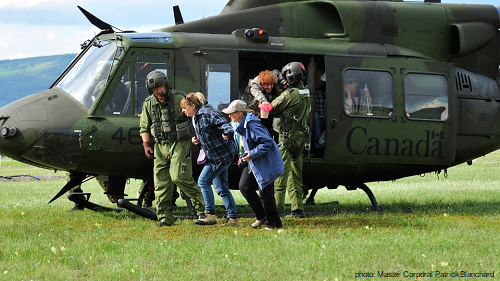Canada’s National Disaster Challenge
by Murray Lee
Background
We are all aware of the four seasons spring, summer, autumn and winter, but as Canadians we now face a new dangerous set of four seasons: floods (spring), fires (summer), severe storms (autumn) and blizzards (winter), all of which can quickly become national disasters. Recent events of this nature demonstrate vividly that we are not prepared nor equipped to deal with such major events in a timely and coordinated manner. Too many piecemeal entities exist across the country which preclude a coordinated national effort to combat these threats quickly and with the necessary resources to carry them out. Although provincial jurisdiction comes into play in most cases, disasters do cross provincial boundaries and call for centralized control but require decentralized execution of tasks. Constantly relying on the Canadian Armed Forces to provide resources is not the solution which can and will degrade the Forces’ war fighting capabilities. So what is the Canadian solution to these more frequent annual events, mainly caused by climate change?
Organizational Structure
Although one does not like to copy constantly examples of the United States, the formation by the Americans of FEMA (Federal Emergency Management Agency), an agency operating under the Department of Homeland Security, addresses most of their disaster response requirements. FEMA coordinates the response to any disaster that has occurred in the United States which overwhelms the resources of local and state authorities. Canada urgently needs to create a new federal department which could mirror FEMA in a number of ways, but most importantly, would provide the centralized control under one Minister to deal with resource allocation. Let’s call it the Department of National Emergency Response (DNER).
The DNER Mission
The DNER would have the responsibility of overseeing the following functions:
- provision of liaison officers to provincial inter-agency coordination centres – a necessity for all provinces and territories;
- direct allocation of resources, manpower and equipment;
- coordinate training of personnel to a common standard;
- coordinate national logistic requirements/stockpiling, and
- coordination and liaison with Department of National Defence (DND), Transport Canada and Fisheries and Oceans Canada.
Treasury Board should be responsible for funding the department based on assessments made by a coordinated effort by each province and the DNER minister. Consider the money spent by each province in providing assistance individually versus using a pooled resource. Each province would contribute to the total package based on need. The biggest budgetary challenge to DNER would be the acquisition and coordination of resources, big ticket items such as aircraft (fire-fighting and evacuation) and watercraft (flood relief and rescue).
It would seem prudent that consideration be given to the formation of a national water bomber force. A decision would have to be made as to who would operate such a resource, e.g. Transport Canada or National Defence. The force would have to be deployable to any province requiring such services and a breakdown between a mix of fixed wing water bombers and helicopters will have to be made once a national inventory of these resources is compiled. This is considered to be most urgent as unless we know what we have to operate with, new equipment requirements cannot be determined. This will have a vital impact on any budget considerations.
Aircraft Resources
It is beyond the scope of this article to determine the best selection and choice of aircraft for the missions of fire-fighting and transport. Suffice it to say, there are a variety of aircraft on the market suitable for Canadian needs from dedicated water bombers to converted commercial transport aircraft. One of the first tasks for DNER once the national inventory of aircraft is made would be to select/purchase or lease such resources but most importantly, who will provide the crews and necessary maintenance for the aircraft. Secondly, where would the aircraft be based if they were pooled as a national resource or would they be parceled out to various provinces based on need and the time of year? There are many critical considerations to be determined and decisions made by this new department – necessary and essential for Canada to look ahead at the increasing threat from the national disaster challenge.
A Link from DNER to DRDC
DRDC stands for Defence Research and Development Canada. It is a science, technology, and innovation leader, trusted advisor, collaborative partner and knowledge integrator for defence and security in Canada. DRDC develops and delivers new technical solutions and advice to the DND, the Canadian Armed Forces, other federal departments, as well as safety and security communities. As such, integrated work between DNER and DRDC would be essential and necessary to assist DNER in its mission. DRDC could provide the necessary assistance to the Minister of DNER to ensure integration of this entire concept.
Summary
In this short overview of the challenge we face in meeting the threat of increasing national disasters, we have attempted to highlight but a few of the issues to be considered in looking ahead. What does quickly come to the fore, however, is the urgent new for a new federal department to oversee, control and contain national disasters as quickly and efficiently as possible. This can only be done by establishing a new Department of National Emergency Response.
Murray Lee is a retired pilot of the Royal Canadian Air Force.

